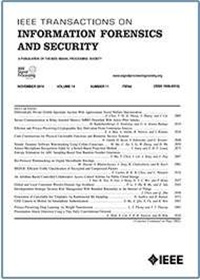一种具有多种数据生成的法医学框架用于通用伪造定位
IF 8
1区 计算机科学
Q1 COMPUTER SCIENCE, THEORY & METHODS
IEEE Transactions on Information Forensics and Security
Pub Date : 2025-09-10
DOI:10.1109/TIFS.2025.3607251
引用次数: 0
摘要
基于深度学习的取证技术已经成为图像伪造定位的主要方法。然而,许多现有的方法与训练数据的过拟合作斗争,这限制了它们的泛化性能和现实世界的适用性。为了克服这一挑战,我们提出了一个新的法医框架,其中包含了先进的数据增强技术。该框架由两个关键组件组成:生成器和检测器。生成器在多样性和一致性约束下挑战检测器的学习分布,确保生成的数据偏离源域,同时保持与篡改相关的统计差异。反过来,检测器从篡改图像的三个关键方面捕获篡改痕迹:远程依赖信息、rgb -噪声融合信息和边界伪影,从而实现更全面的检测过程。通过交替优化生成器和检测器,该框架促进了相互强化,促进了多样化的数据生成并扩大了分布覆盖范围,最终提高了性能。大量的实验表明,所提出的方法在泛化和鲁棒性方面都明显优于最先进的方法,大量的消融研究进一步验证了模型设计的合理性。本文章由计算机程序翻译,如有差异,请以英文原文为准。
A Forensic Framework With Diverse Data Generation for Generalizable Forgery Localization
Deep learning-based forensic techniques have emerged as the leading approach for image forgery localization. However, many existing methods struggle with overfitting to the training data, which limits their generalization performance and real-world applicability. To overcome this challenge, we propose a novel forensic framework that incorporates an advanced data augmentation technique. The framework consists of two key components: a generator and a detector. The generator challenges the detector’s learned distribution under constraints of diversity and consistency, ensuring that the generated data diverges from the source domain while maintaining statistical differences related to tampering. The detector, in turn, captures tampering traces from three critical aspects of the tampered image: long-range dependency information, RGB-noise fusion information, and boundary artifacts, resulting in a more comprehensive detection process. By alternating the optimization of the generator and detector, the framework fosters mutual reinforcement, promoting diverse data generation and expanding the distributional coverage, ultimately improving performance. Extensive experiments demonstrate that the proposed method significantly surpasses state-of-the-art approaches in both generalization and robustness, with numerous ablation studies further validating the soundness of the model design.
求助全文
通过发布文献求助,成功后即可免费获取论文全文。
去求助
来源期刊

IEEE Transactions on Information Forensics and Security
工程技术-工程:电子与电气
CiteScore
14.40
自引率
7.40%
发文量
234
审稿时长
6.5 months
期刊介绍:
The IEEE Transactions on Information Forensics and Security covers the sciences, technologies, and applications relating to information forensics, information security, biometrics, surveillance and systems applications that incorporate these features
 求助内容:
求助内容: 应助结果提醒方式:
应助结果提醒方式:


